Previously, we published an article entitled Facts about the Kidneys. This article focuses on the facts about kidney stones. Kidney stones are on the rise for a number of reasons that will be highlighted as well.
What are Kidney Stones?
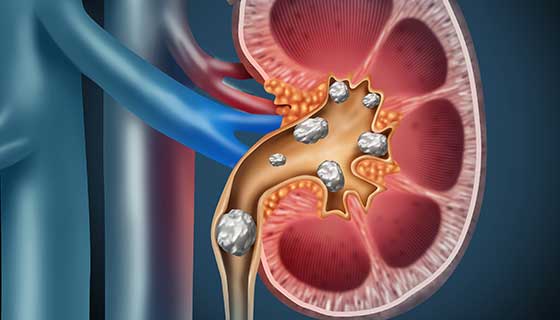
Kidney stones (aka renal calculi, nephrolithiasis, or urolithiasis) are solid deposits composed of minerals and salts that develop inside the kidneys and stick together in concentrated urine.
There are various types of kidney stones depending on how they are produced and the substances that form them. Typical forms of kidney stones include uric acid stones, calcium stones, struvite stones, and cystine stones.
What Causes Kidney Stones
Kidney stones can have an effect on any part of the urinary tract, including the area from the kidneys to the bladder. Frequently, stones appear when the urine becomes concentrated, which allows minerals to crystallize and stick together.
Diet, additional body weight, certain medical conditions, and certain supplements and medications are among the various causes of kidney stones. These causes are explained in detail below.
Inadequate Hydration – Poor hydration is one of the most common causes of kidney stones. The crystallization progression that forms kidney stones is more likely to take place if the body suffers from persistent low hydration. Poor hydration can be the consequence of inadequate water intake or excess sweating during physical activity.
Drinking adequate amounts of water daily can keep the body hydrated and therefore reducing the risk of developing kidney stones. If an individual sweats too much for any reason, exercises intensely, or carries out physical activity over long periods, that person should make an effort to sip water throughout the day.
Foods With Excessive Oxalates – Even though leafy green vegetables have positive benefits, eating them in excess is a potential cause of kidney stones. This is because foods like spinach, rhubarb, and beets contain high
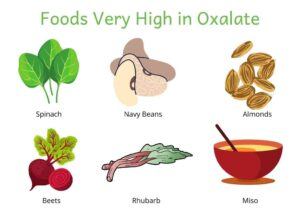 amounts of oxalates, which are compounds that combine with calcium to form a majority of kidney stones.
amounts of oxalates, which are compounds that combine with calcium to form a majority of kidney stones.
When foods high in oxalates are consumed in moderate quantities, the oxalates are usually excreted in the urine. However, when an individual frequently consumes large amounts of foods high in oxalates, the quantity of oxalates becomes too elevated for excretion. Therefore, when the oxalates combine with calcium, calcium stones form. Because of this, It is best to avoid being over-enthusiastic while eating foods high in oxalates. Additionally, there are leafy green vegetables that are low in oxalates, like kale.
Excessive Sodium (Salt) Intake – Excessive sodium intake is another probable cause of kidney stones. High sodium ingestion leads to increased calcium levels and exhausted citrate levels in urine. Citrate is known to hinder stone formation. These two factors increase the risk of kidney stone formation.
Studies indicate that reducing salt intake to no more than 1,200 mg per day and limiting protein intake cut down recurrent kidney stone formation by half among people who suffer from chronic kidney stones. According to the study, reduction in salt intake has significantly better results than reducing calcium intake.
The FDA (Food and Drug Administration) recommends that the general population consume no more than 2,300 mg of table salt per day. In addition, those individuals with high blood pressure and who are middle-aged or older should limit their intake to no more than 1,500 mg a day.
Protein From Animals – Animal protein can lead to high urine acidity, for example, beef and shellfish. The digestion of animal protein creates uric acid, which is known to bring about gout. Uric acid can also gather in the kidneys and result in kidney stones. Animal protein can additionally increase calcium levels in urine as well as reduce the amount of citrate in the body. Both these factors increase the risk of kidney stone formation.
However, this does not mean that animal protein should be avoided altogether. In contrast, consuming animal protein in moderate amounts and monitoring other known dietary causes of kidney stones can reduce the risk considerably.
Insufficient Calcium Intake – While extra calcium can unite with oxalates to form calcium stones, low calcium intake can also lead to kidney stone development. Calcium readily binds to oxalates, which works completely when there is the right amount of calcium in the diet.
Dietary calcium combines with oxalates in the small intestine. This combination enables the oxalates to be expelled in the stool instead of being absorbed into the bloodstream. However, when calcium intake is insufficient, the oxalates are soaked up into the bloodstream. Once they arrive at the kidneys, they combine with the available calcium to form calcium stones. Shop for calcium online [affiliate link]
Digestive Issues – Some gut problems are potential causes of kidney stones. Inflammatory bowel diseases, such as ulcerative colitis and Crohn’s disease, can bring about diarrhea, which results in severe fluid loss. Fluid loss, in turn, reduces the amount of water accessible for urine production.
Low hydration additionally directs to a high concentration of minerals and acids in the body, particularly in the kidneys and the urinary tract. Large amounts of minerals and acids in the urinary system and the subsequent low urine volume increase the risk of kidney stones.
Excess Weight-Obesity – Obesity, which is identified as a body mass index (BMI) bigger than 30, has been connected to the development of kidney stones. Additionally, being overweight or obese causes numerous other health problems, including type 2 diabetes, high blood pressure, and heart disease.
According to some research, obesity directs to insulin resistance. Consequently, this lessens the urinary secretion of ammonium compounds from the body. This reduction increases urine acidity and leads to the buildup of uric acid in the kidneys and the urinary tract. These increased uric acid levels in the urinary system can cause uric acid stones to form.
Excessive Sugar – Excessive sugar ingestion may lead to the formation of kidney stones. A large number of foods, mainly processed foods, either contain sugar or are broken down into sugar. Therefore, when individuals consume products such as soda, french fries, bread, and cakes, the body can be inundated with a lot of sugar. These large amounts of sugar interfere with the absorption of minerals, for instance, magnesium and calcium, which increases the risk of developing kidney stones.
Researchers connect the increasing number of young children with kidney stones to the increased ingesting of sugary foods. Additionally, studies have found that reducing sugar intake reduces the risk of recurrent kidney stones.
Medications – Individuals taking medications such as diuretics and high-calcium antacids have a higher risk of developing kidney stones. Diuretics decrease the quantity of water in the body. This decrease in water raises the level of minerals in the kidneys and the urinary tract, making kidney stones more likely. In addition, the long-term use of high-calcium antacids increases the amount of calcium in the urine.
These medications increase the risk of developing calcium stones in the kidneys and the entire urinary system. In addition, taking large amounts of vitamin A and vitamin D or drugs such as indinavir, phenytoin, and antibiotics such as ciprofloxacin and ceftriaxone may additionally amplify the risk of getting kidney stones.
Heredity – Individuals are more susceptible to getting kidney stones if other family members have had them. Hypercalciuria, or continually high calcium levels in the urine, is a basis for hereditary kidney stones. In a majority of cases, kidney stones consist of calcium. The condition can be passed down from generation to generation and is a predisposing factor for kidney stones.
Hereditary diseases that affect people’s capability to process compounds like oxalate, uric acid, and the amino acid cysteine additionally increase kidney stones risk. Renal tubular acidosis is an additional genetic condition in which kidney stones are more likely to transpire.
Symptoms of Kidney Stones
Depending on the size and location of the stone, it can cause different signs and symptoms. Usually, kidney stones cause no symptoms if they are small enough to leave the body through the urine. The majority of the symptoms 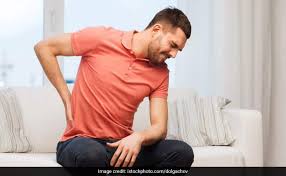 linked to this condition are due to stones that have become trapped in some areas of the urinary tract. These are usually the ureters, which are the tubes that connect the kidneys to the bladder.
linked to this condition are due to stones that have become trapped in some areas of the urinary tract. These are usually the ureters, which are the tubes that connect the kidneys to the bladder.
Abdominal Pain – Abdominal pain is an ambiguous indicator linked with many conditions. The location and characteristics of the pain can assist in distinguishing between different diseases and conditions, and it can be beneficial information to the clinicians to provide an accurate diagnosis.
When a kidney stone becomes lodged in the urinary tract, it can cause a tremendous amount of pain. Once a stone has become trapped, the ureter will spasm, causing the classic renal colic. Renal colic is described by sharp and sudden pain in the affected side of the abdomen. Generally, the pain comes and goes as the ureter spasms repetitively. This pain is known to be extremely rigorous and may last a few hours until it starts to calm down. The pain has been equated with childbirth labor pains.
Back Pain – Pain in the lower portion of the back is one of the most common medical complaints worldwide, next to pain in the neck. It is also a non-specific symptom associated with numerous conditions. It can have a severe start that is usually seen in conditions affecting the musculature of the back. However, sometimes, it can have a subtle onset that makes it difficult to diagnose.
Depending on where the stone is located, it can cause different signs and symptoms. For example, kidney stones that become lodged in the lower portion of the ureter, where the ureter and bladder meet, cause lower back pain. It is additionally possible for the back to be tender to the touch if the affected kidney is struggling to push urine out due to the blockage in the urinary tract.
Pain in the Groin – Groin pain is yet another non-specific symptom associated with numerous conditions. Given the many muscles located in this region, it is usual to experience groin pain due to muscle cramps, tears, and strains. Muscle injuries generally have a sharp and sudden start right after the causing trauma takes place. Other conditions such as hernias and even nephrolithiasis are also known to cause pain in the groin.
Kidney stones that become trapped in the lower portion of the ureter can cause groin pain. Individuals with stones have also reported testicular pain in males and pain in the labia majora for females. This is called referred pain (pain felt at a location different from the injured or diseased organ or body part).
Dark or Red Urine – Hematuria is the medical name used to explain the blood in the urine. When an individual sees blood in their urine, this is called macroscopic hematuria. On the other hand, some patients may have blood in their urine, and the amount is so minuscule that it is only visible during a urine analysis, which is called microscopic hematuria.
More than half of the individuals in distress from kidney stones have either macroscopic or microscopic hematuria. As the stone travels through the urinary tract, it can damage it, causing blood to be seen in the urine.
Urinating Pain – Dysuria is the medical term used to express the presence of pain in the course of urination. It is an imprecise indicator linked with numerous conditions such as urinary tract infections (UTI), kidney stones, and sexually transmitted infections (STI), to name a few. This symptom is frequently depicted as a burning sensation during urination, and it can be an extremely painful experience.
This symptom can be seen in patients with kidney stones lodged at the point where the ureter joins with the bladder. It may additionally be a sign that an underlying urinary tract infection might be at hand as well.
Other possible symptoms include:
- Nausea
- Frequent Urination
- Increased heart rate
- Fever
Treating Kidney Stones
The treatment for kidney stones differs, depending on the kind of stone and the origin.
Most small kidney stones do not require invasive treatment involving surgery. An individual may be able to pass a small stone by:
- Drinking water. Drinking as much as 2 to 3 quarts (1.8 to 3.6 liters) a day will keep the urine diluted and may avert stones from forming. Unless a doctor indicates otherwise, drink enough fluid, ideally water mostly, to produce clear or nearly clear urine.
- Pain relievers. Passing even a tiny stone can cause some distress. To relieve mild pain, a physician may suggest pain relievers such as ibuprofen (Advil, Motrin IB Profen, others) or naproxen sodium (Aleve).
- Medical therapy.
A physician may give an individual a medication to help pass the kidney stone. This kind of medication, known as an alpha-blocker, relaxes the muscles in the ureter, helping to pass the kidney stone faster and with less pain. Illustrations of alpha-blockers include tamsulosin (Flomax) and the drug combination dutasteride and tamsulosin (Jalyn).
On the other hand, kidney stones that are too excessive in size to pass on their own or initiate bleeding, kidney injury, or constant urinary tract infections may necessitate more extensive treatment. Procedures can include:
- Using sound waves to crumble stones. For specific kidney stones, based on size and location, a physician may advise a method called extracorporeal shock wave lithotripsy (ESWL).
ESWL uses sound waves to create strong vibrations (shock waves) that
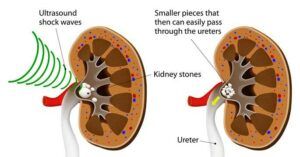
shatter the stones into tiny pieces that are passed in the urine. The process lasts about 45 to 60 minutes and may cause moderate pain. Therefore, an individual may be under sedation or light anesthesia to make them comfortable.
ESWL can bring about blood in the urine, bruising on the back or abdomen, bleeding around the kidney area and other neighboring organs, and irritation as the stone fragments passes through the urinary tract.
- Surgery to eliminate the large stones in the kidney. A procedure known as percutaneous nephrolithotomy (nef-row-lih-THOT-uh-me) involves surgically removing a kidney stone using small telescopes and instruments placed through a small incision in the back.
The patient will receive general anesthesia during the surgery and will remain in the hospital for one to two days to recover. The physician may advise this surgery if ESWL is not successful.
- Using a scope to eliminate stones. To remove a smaller stone in the ureter or kidney, a physician may insert a thin, lighted tube (ureteroscope) equipped with a camera through the urethra and bladder to the ureter.
Once the stone is sited, special tools can ensnare the stone or break it into pieces that will pass in the urine. A physician may then place a small tube (stent) in the ureter to relieve swelling and promote healing. General or local anesthesia is administered during this procedure.
- Parathyroid gland surgery. Some calcium phosphate stones are caused by overactive parathyroid glands located on the four corners of your thyroid gland, just below the Adam’s apple. When these glands produce excess amounts of the parathyroid hormone (hyperparathyroidism), calcium levels can become too high, and kidney stones can form as a result.
- Hyperparathyroidism occasionally occurs when a small, benign tumor forms in one of the parathyroid glands or an individual develop another condition that leads these glands to produce more parathyroid hormone. Removing the tumor from the gland terminates the formation of kidney stones. On the other hand, the doctor may recommend handling the condition that is causing the parathyroid gland to overproduce the hormone.
How to Prevent Kidney Stones
Prevention is better than cure. To prevent kidney stones, one may want to
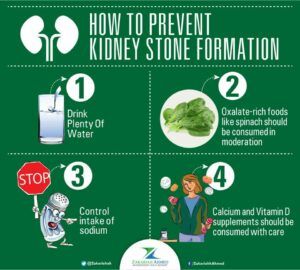
include a combination of lifestyle changes and medications.
An individual may reduce the risk of kidney stones if he or she:
- Consumes water throughout the day. Doctors usually recommend drinking enough fluids to pass about 2.1 quarts (2 liters) of urine for people with a history of kidney stones a day. A doctor may ask a patient to measure their urine output to ensure they are drinking enough water.
Individuals who live in a hot, dry climate or exercise frequently may need to consume even more water to produce enough urine. On the other hand, if urine is clear or light in color, enough water is being consumed in all probability.
- Consumes fewer oxalate-rich foods. For individuals that tend to form calcium oxalate stones, a doctor may recommend limiting foods that are rich in oxalates. These include spinach, beets, sweet potatoes, nuts, tea, chocolate, black pepper, rhubarb, okra, Swiss chard, and soy products.
- Chose a diet light in salt and animal protein. Reduce the amount of salt consumed and choose non-animal protein sources, such as legumes. Contemplate using a salt substitute.
- Consumes calcium-rich foods, but use discretion with calcium supplements. Calcium in food does not affect the risk of kidney stones. Therefore, continue consuming calcium-rich foods unless a doctor advises otherwise.
It is best to consult with a doctor before taking calcium supplements, as these have been linked to an increased risk of kidney stones. An individual may reduce the risk by taking supplements with meals. In addition, diets low in calcium can escalate kidney stone formation in some individuals.
One can also ask a doctor for a referral to a dietitian who can help develop an eating plan that reduces the risk of kidney stones.
Medications can control the number of minerals and salts in the urine and may be helpful in individuals who form certain kinds of stones. The type of medication a doctor prescribes will depend on the type of kidney stones an individual may have.
Kidney stones are on the rise. One of the reasons is poor diet choices. Fast and processed foods contain large amounts of sodium. As you read earlier, excess sodium can lead to stones.
Kidney stones are also more apparent in the summer. The reason for this also due to calcium. Studies have shown that the body produces more calcium in the urine during the winter months, leading to hypercalciuria.
Kidney stones can be a severe condition. However, in most cases, they are preventable.
If you have a comment, question, or concern, or if you have had experience with kidney stones you’d like to share, please do so below.
Good Health!!
I must admit, I am completely guilty when it comes to not drinking anywhere near enough water as i should be drinking. However, when I read your article here, it kinda reminds me of just how painful a kidney stone can be. So I am going to make sure that i drink much more water for a start.
I am happy that this article serves as a wake-up call for you. Kidney stones are no joke!
All the best!
Hi Nathaniel, and what an informative post you have here on kidney stones. I know several people who have had kidney stones, and I also believe that prevention is better than trying to find a cure. I think I will watch my diet of oxalate-rich foods, drink plenty of water, and be careful of using too much salt, and animal proteins. Having healthy organs go a long way in maintaining our health.
Well, Carolyn, you certainly have the prescription down solid! You’re correct; prevention is always better than cure!
Thanks for commenting!